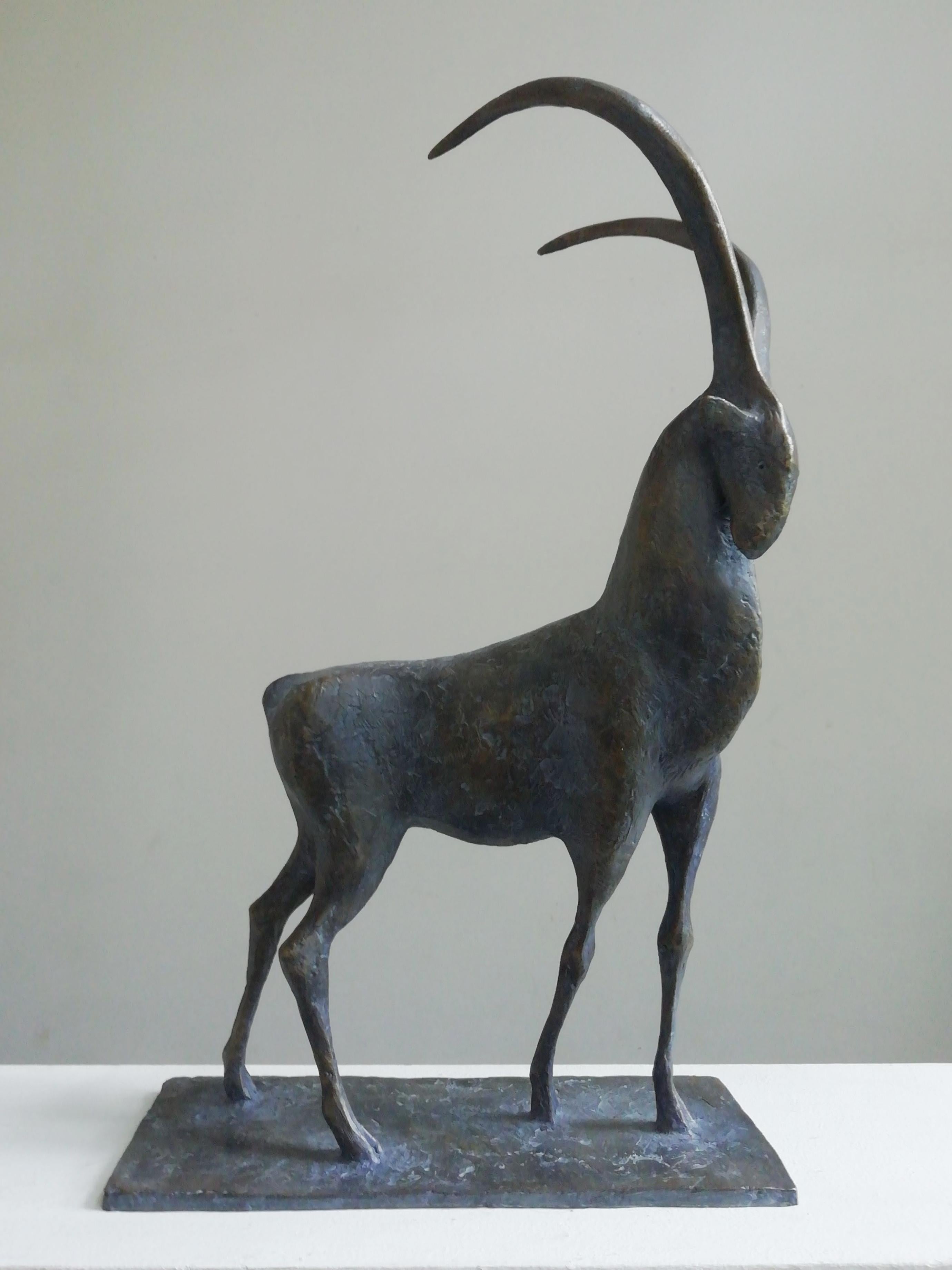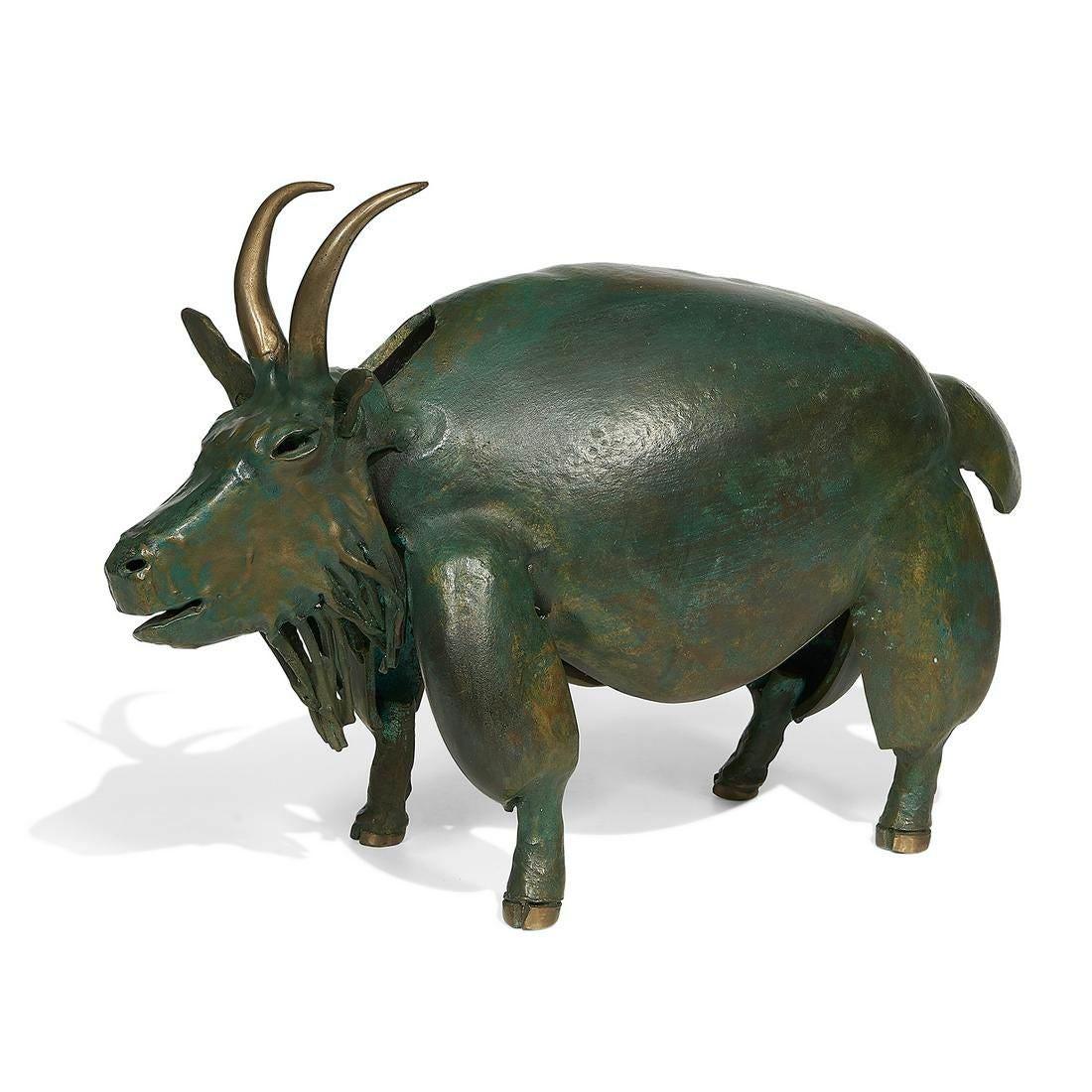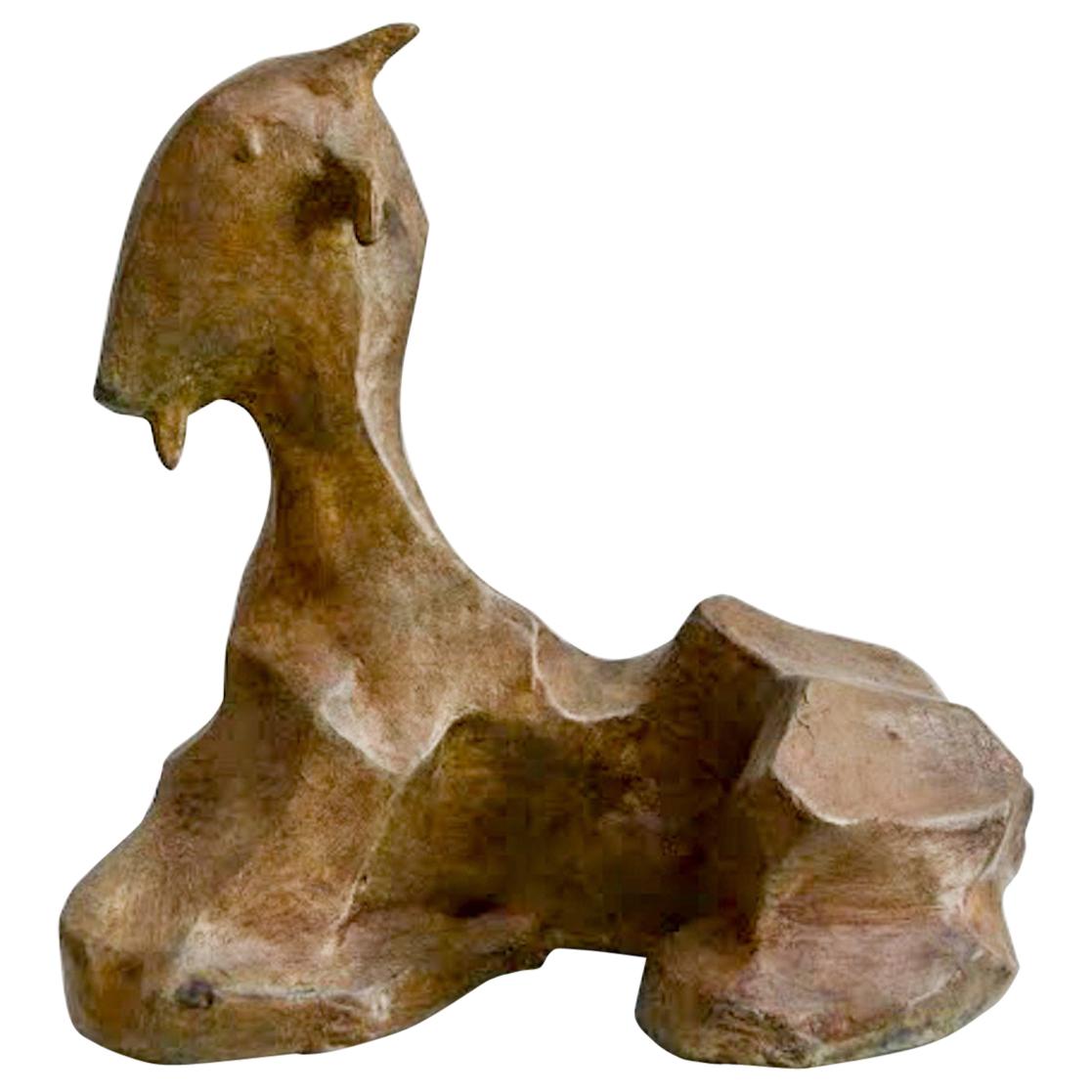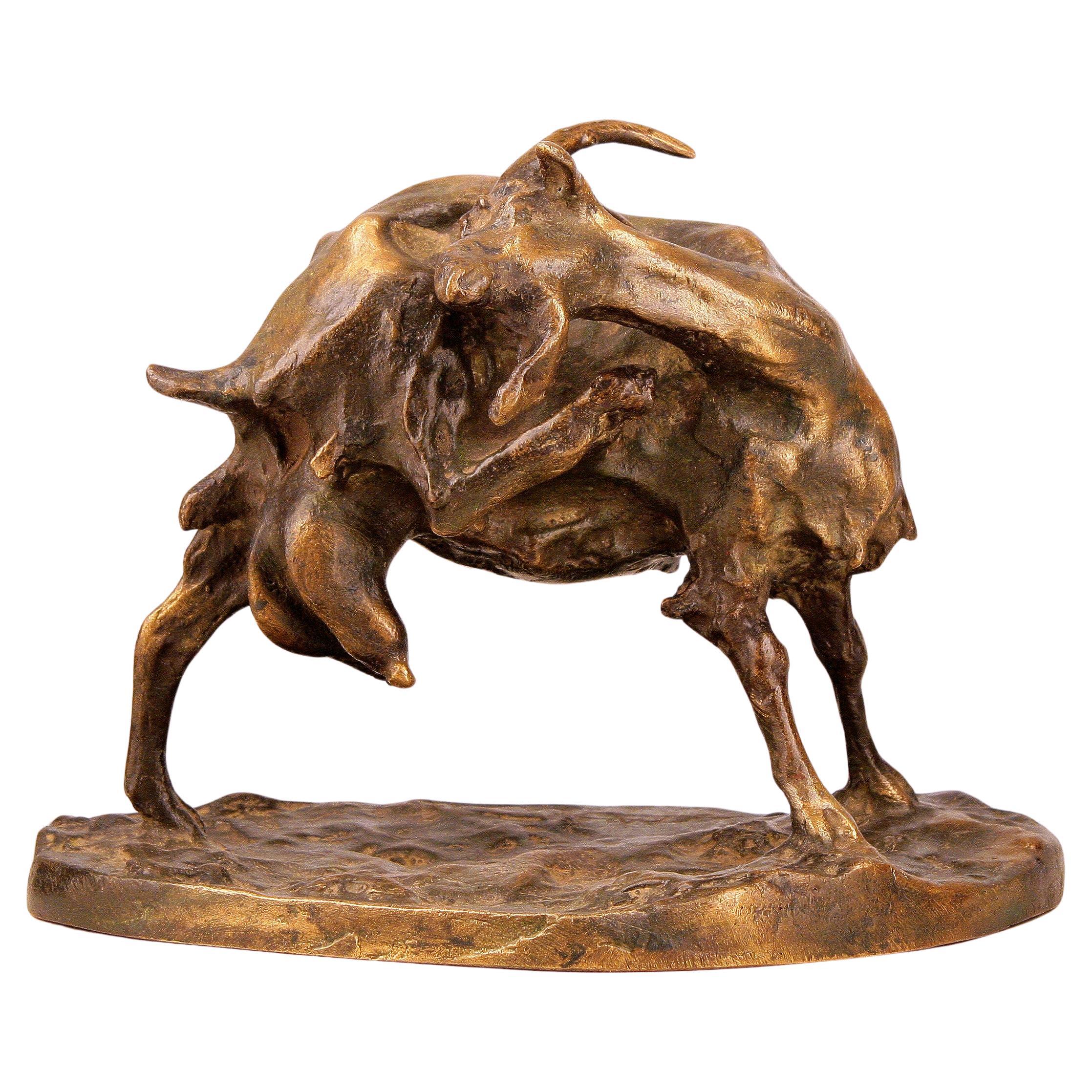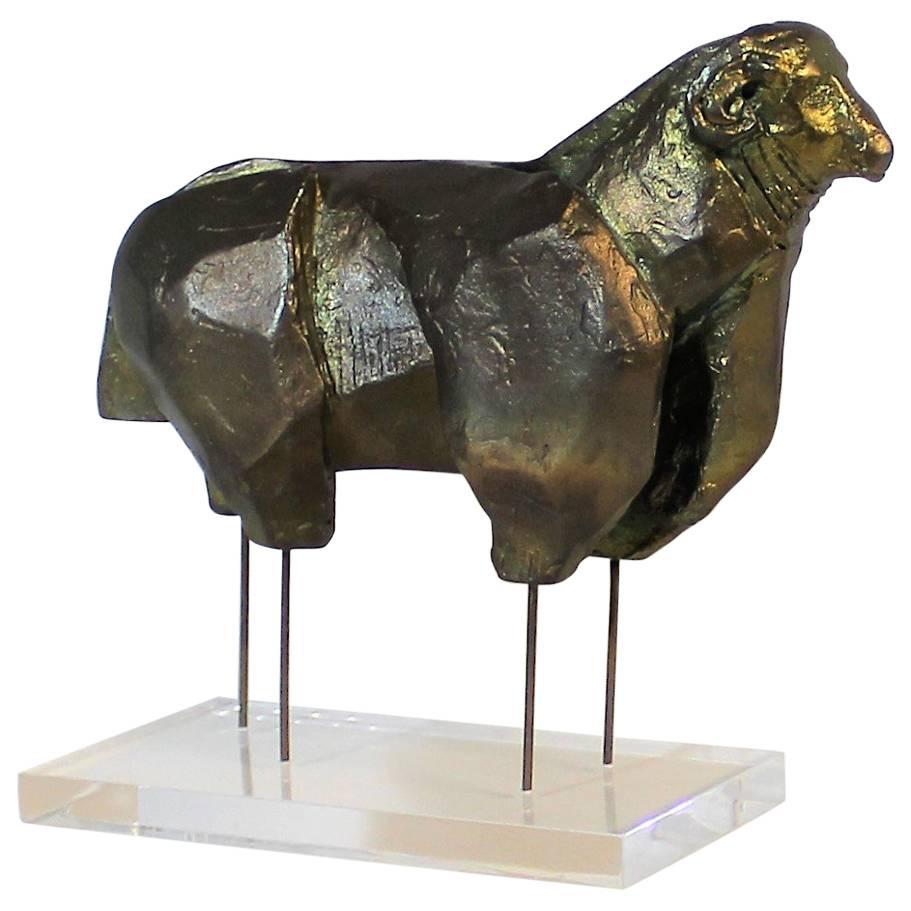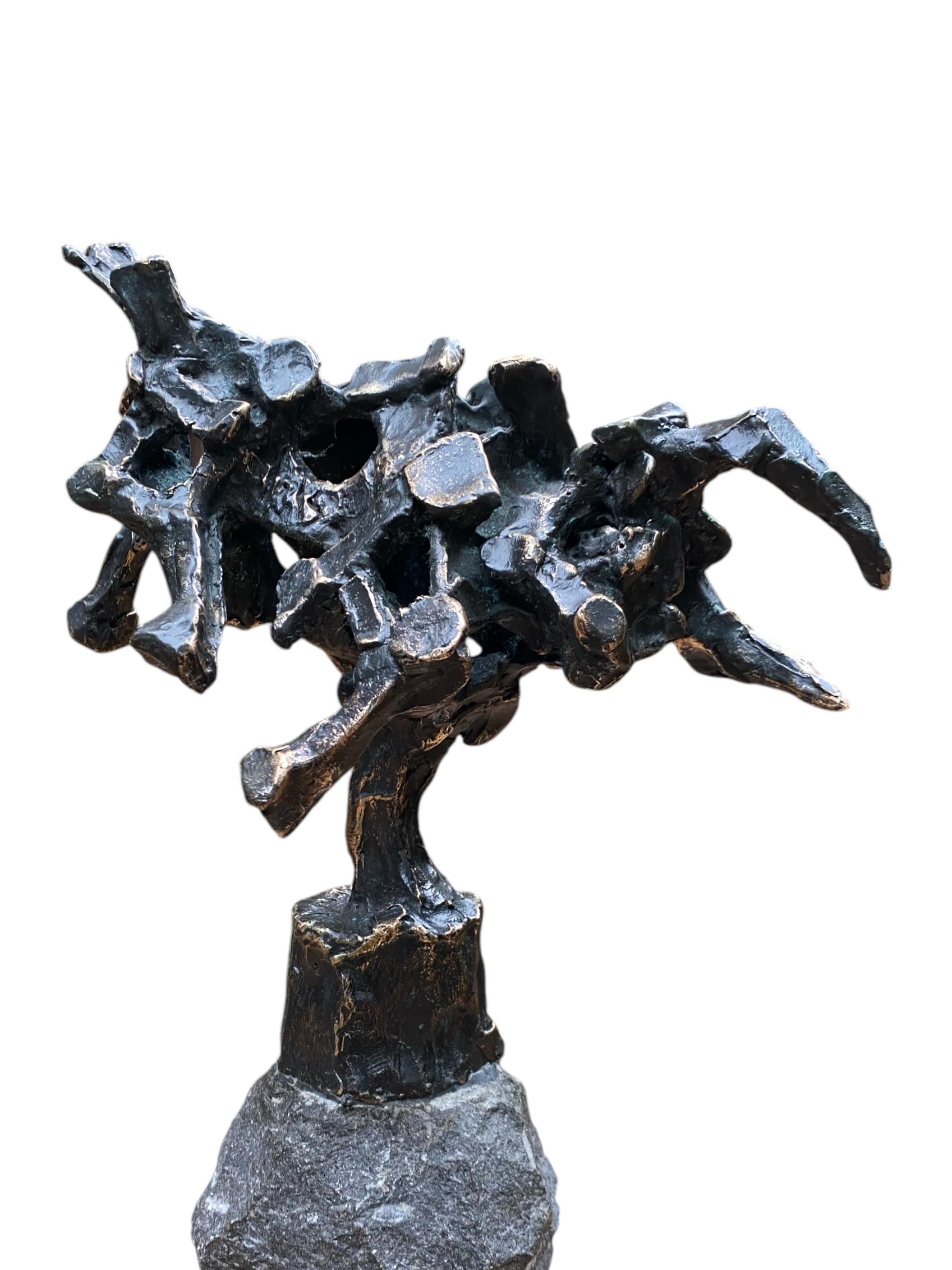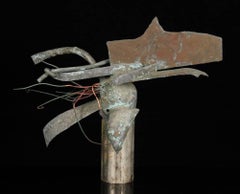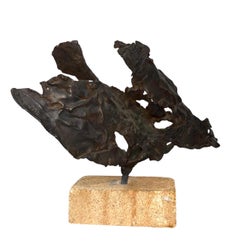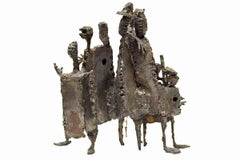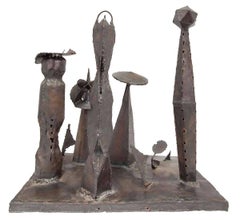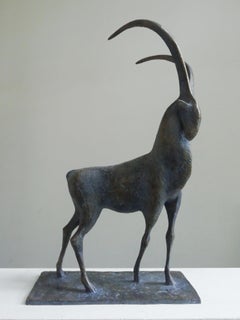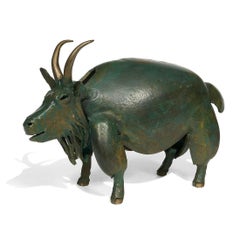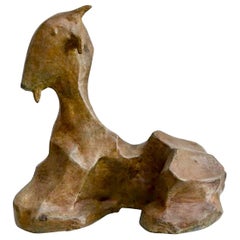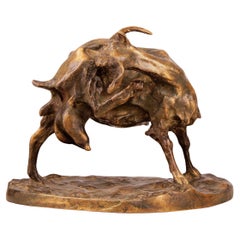Items Similar to Bronze Sculpture Abstract Brutalist Goat or Ram WPA Artist Mounted on Base
Want more images or videos?
Request additional images or videos from the seller
1 of 8
Benedict Michael TattiBronze Sculpture Abstract Brutalist Goat or Ram WPA Artist Mounted on Basec.1950's
c.1950's
$4,500
£3,361.28
€3,896.87
CA$6,248.14
A$7,003.36
CHF 3,646.44
MX$85,514
NOK 46,296.58
SEK 43,884.99
DKK 29,074.90
Shipping
Retrieving quote...The 1stDibs Promise:
Authenticity Guarantee,
Money-Back Guarantee,
24-Hour Cancellation
About the Item
Benedict Tatti (1917-1993) worked in New York city as a sculptor, painter, educator, and video artist. He studied stone and wood carving under Louis Slobodkin at the Roerich Museum. He later attended the Leonardo da Vinci School of Art studying under Attilio Piccirelli. In l939 he taught adult classes with the Teachers Project of the WPA and attended the Art Students League for three and a half years on full scholarship. He studied under William Zorach and Ossip Zadkine and later became Zorach’s assistant. Later in his career, he attended the Hans Hofmann School of Fine Arts. During World War II, Tatti served in the United States Army Air Force, where he spent three years assigned to variety of projects. In 1948, Benedict Tatti married Adele Rosenberg in New York City.
Throughout his career, Tatti continuously experimented with various media. From 1952-1963, Tatti executed sculptural models of architectural and consumer products for the industrial designers, Raymond Loewy Associates; later he became a color consultant for the firm. In the 1960s, influenced by the Abstract Expressionists, Tatti turned from carving directly in wood and stone to creating assemblage architecture sculptures, using bronze metal and other industrial materials.
He was included in the important show "Aspects de la Sculpture Americaine", at Galerie Claude Bernard Paris, France, in October 1960 along with Ibram Lassaw, Theodore Roszak, David Smith, Louise Bourgeois, Danese Corey, Dorothy Dehner, Lin Emery, Lily Ente, David Hayes, Louise Nevelson, Tony Rosenthal, Richard Stankiewicz, Sam Szafran and Benedict Tatti. During this period, Tatti spent summers on Monhegan Island in Maine, where he developed his watercolor techniques. In the 1970s, Tatti, with no previous background in video work developed technology for video imaging. He became an associate member of the Kitchen at the Mercer Arts Center exhibiting his video sculptures along with other early innovators of this new art form. He assisted his brother, Alexander Tatti and his nephew, Steven Tatti on the restoration of the Statue of Liberty on Ellis Island. Benedict Tatti received solo and group exhibitions at museums and galleries in the United States and abroad, including the Burr Gallery, Claude Bernard Galleries, ACA Gallery, Puma Gallery, Weyhe Gallery and Metropolitan Museum of Art, under the Artists for Victory Program, Museum of Modern Art, National Gallery of Art, Northeast Gallery, Pennsylvania Academy of the Fine Arts, and the Roko Gallery. Also, Tatti's work was regularly featured in annual exhibitions of several arts organizations: American Society of Contemporary Artists, Annual Avant Garde Festival, Audubon Artists, Brooklyn Society of Artists, and Painters and Sculptors Society of New Jersey. His awards included the National Soldier Art Competition at the National Gallery of Art (1945); Artist-in-Residence, National Center of Experiments TV, San Francisco, California, (1969); and the Creative Artists Public Service (CAPS), (1972). Tatti's artwork is in the permanent collections of the American Numismatic Society, Art Students League, Dumbarton Oaks, Monhegan Museum, Smithsonian Institution, and the Usdan Center for the Creative and Performing Arts.
He won first prize for his sculpture, “Soldier”, in the National Soldier Art Competition, which was exhibited at the National Gallery of Art, Washington, D. C. and the Chicago Art Institute. He continued to direct carve both wood and stone into the decade of the fifties. He also developed his watercolor techniques during summer visits to Monhegan Island, Maine, where many of his friends summered.
- Creator:Benedict Michael Tatti (1917 - 1993, American)
- Creation Year:c.1950's
- Dimensions:Height: 13 in (33.02 cm)Width: 15 in (38.1 cm)Depth: 6 in (15.24 cm)
- Medium:
- Movement & Style:
- Period:
- Condition:good. base has minor wear.
- Gallery Location:Surfside, FL
- Reference Number:1stDibs: LU38215114312
About the Seller
4.9
Platinum Seller
Premium sellers with a 4.7+ rating and 24-hour response times
Established in 1995
1stDibs seller since 2014
1,777 sales on 1stDibs
Typical response time: <1 hour
- ShippingRetrieving quote...Shipping from: Surfside, FL
- Return Policy
Authenticity Guarantee
In the unlikely event there’s an issue with an item’s authenticity, contact us within 1 year for a full refund. DetailsMoney-Back Guarantee
If your item is not as described, is damaged in transit, or does not arrive, contact us within 7 days for a full refund. Details24-Hour Cancellation
You have a 24-hour grace period in which to reconsider your purchase, with no questions asked.Vetted Professional Sellers
Our world-class sellers must adhere to strict standards for service and quality, maintaining the integrity of our listings.Price-Match Guarantee
If you find that a seller listed the same item for a lower price elsewhere, we’ll match it.Trusted Global Delivery
Our best-in-class carrier network provides specialized shipping options worldwide, including custom delivery.More From This Seller
View AllBrutalist Bronze Abstract Modernist Sculpture
Located in Surfside, FL
In the manner of Julio Gonzalez, mixed metal sculpture.
Neo-Dada Abstract Sculpture: Assemblages
Abstract sculpture followed a slightly different course. Rather than focusing on non-figurative subject matter, it concentrated on materials, hence the emergence of Assemblage Art - a form of three-dimensional visual art made from everyday objects, said to be 'found' by the artist (objets trouves). Popular in the 1950s and 1960s in America, assemblage effectively bridged the gap between collage and sculpture, while its use of non-art materials - a feature of Neo-Dada art - anticipated the use of mass-produced objects in Pop-Art. Assemblage sculpture is exemplified by the works of Louise Nevelson (1899-1988), such as Mirror Image 1 (1969, Museum of Fine Arts, Houston), and by Jean Dubuffet (1901-85) and his Monument with Standing Beast (1960, James R. Thompson Center, Chicago). The idiom was considerably boosted by an important exhibition - "The Art of Assemblage" - at the Museum of Modern Art, in New York, in 1961.
Other examples of the Neo-Dadaist-style "junk art...
Category
20th Century Abstract Expressionist Abstract Sculptures
Materials
Bronze, Copper
Brutalist Israeli Bronze Abstract Sculpture Wave Form Zvi Aldouby
Located in Surfside, FL
Zvi Yehuda Aldouby (1904 - 1996) was active/lived in Israel. Zvi Aldouby is known for Artist, teaching.
Biography photo for Zvi Jehuda Aldouby
Zvi Yehuda Aldouby (Hirsch Leib Zupni...
Category
1950s Abstract Sculptures
Materials
Limestone, Bronze
Mid Century Modern Brutalist Welded Expressionist Sculpture
Located in Surfside, FL
In this bronze sculpture the artist (unknown) has welded together a group of figures into a unified piece. These figures take on animal, and human characteristics, which is evident i...
Category
Mid-20th Century Abstract Expressionist Abstract Sculptures
Materials
Metal
Mid Century Modern Brutalist Welded Expressionist Sculpture After Paul Evans
Located in Surfside, FL
In this bronze sculpture the artist (unknown) has welded together a group of totems or monuments into a unified piece. T
Neo-Dada Abstract Sculpture: Assemblages
In contrast, abstra...
Category
Mid-20th Century Abstract Expressionist Abstract Sculptures
Materials
Metal
Large Latin American Modernist Bronze Abstract Cuban Master Roberto Estopinan
By Roberto Estopiñan
Located in Surfside, FL
Roberto Estopinan, Cuban, 1920 - 2015
Dimensions: 24.5" wide x 13" high plus 6" high base.
Roberto Estopiñán (1921–2015) was a Cuban American sculptor known for his sculptures of the human form, including political prisoners. Born in Camaguey, Cuba, he lived in the United States for over fifty years. His works are held by major institutions such as the Museum of Modern Art, the Whitney Museum and the Smithsonian Museum of American Art.
Roberto Gabriel Estopinan, a sculptor, draftsman, and printmaker, was born in Havana, Cuba on March 18, 1921. Estopiñán enrolled at the San Alejandro Academy when he was just 14 years old and became the protegé and studio assistant of the sculptor Juan José Sicre. After graduation he traveled first to Mexico, where he met and befriended Francisco Zuniga, and studied Pre-Columbian sculpture. In 1949 he traveled to Europe, visiting England, France and Italy. In these trips he encountered the sculpture of Henry Moore and Marino Marini, and their humanistic yet formal visions would be influential on Estopinan's work. Estopiñán was a pioneer of direct carvings using wood and of welding techniques in Latin America. Throughout the 1950s, Estopiñán received important prizes at various national exhibitions in Havana. In 1953 he was the only semi-finalist from Latin America at the Tate Gallery's international sculpture competition for a Monument to the Unknown Political Prisoner. In 1961, the artist moved to New York, where he resided until 2002.
Roberto Gabriel Estopiñán a Cuban emigre sculptor who emigrated to exile in the United States not long after Fidel Castro’s revolution in 1959, is considered one of Latin America’s most important 20th-century artists. His work, which includes drawings and prints as well as sculptures in wood and bronze, is in the collections of New York’s Museum of Modern Art, the Smithsonian’s American Art Museum, the Art Institute of Chicago, and the Detroit Institute of Art, among many locations. He is best known for his stark, disturbing renderings of political prisoners, the fruit of his own experiences as a dissident under both Castro and his predecessor, the dictator Fulgencio Batista, and for his representations of the female torso that can remind viewers of both classical statuary and the high-modern, abstractly elongated work of Henry Moore.mHe was born in Havana to a father from Asturias in northwest Spain and a mother of African descent. Estopiñán was something of a prodigy. At the age of fourteen, he won the first prize in drawing at the Centro Asturiano, a regional association for Cubans of Asturian descent. Shortly afterward he received special permission to enter the San Alejandro Academy of Fine Arts in Havana. At the school he was mentored first by its director, the painter Armando Menocal (1863-1941), then by the landscape artist Antonio Rodríguez Morey (1872-1967), and finally by Juan José Sicre (1898-1974), regarded as one of Cuba’s greatest sculptors. Sicre, a professor of sculpture at the Academy, had helped introduce European modernist art to Cuba, and from the 1930s through the 1950s had sculpted monumental figures in Havana of José Martí and other Cuban national heroes that stand to this day. Estopiñán was first Sicre’s student, then his assistant, and, finally, his colleague for the next fifty years. After graduating from San Alejandro in 1942, Estopiñán began simultaneously teaching art at the Ceiba del Agua School for young men, assisting Sicre in public art projects and developing his own artistic vision. He also traveled widely, to Mexico, New York, France, and Italy. From the late 1940s through the 1950s his sculpture evolved from an early neoclassical phase under the influence of Maillol to what he defined as “formalist humanism”: emphasizing the abstract beauty of the shapes he sculpted while not abandoning the human figure as the basis of his work. As the 1950s progressed he chose to carve in native Cuban woods...
Category
20th Century Abstract Figurative Sculptures
Materials
Bronze
Mid Century Modern Brutalist Welded Abstract Expressionist Sculpture
Located in Surfside, FL
Neo-Dada Abstract Sculpture: Assemblages
In contrast, abstract sculpture followed a slightly different course. Rather than focusing on non-figurative subject matter, it concentrated...
Category
Mid-20th Century Abstract Expressionist Abstract Sculptures
Materials
Metal
You May Also Like
Ibex by Pierre Yermia - Contemporary animal bronze sculpture, mountain goat
By Pierre Yermia
Located in Paris, FR
Ibex is a bronze sculpture by French contemporary artist Pierre Yermia.
Dimensions: 62 × 37 × 16 cm (24.4 × 14.6 × 6.3 in).
The sculpture is signed and numbered, it is part of a lim...
Category
2010s Contemporary Figurative Sculptures
Materials
Bronze
Rocky Mountain Goat, bronze 20th century sculpture of a goat
By John Kearney
Located in Beachwood, OH
John Kearney (American, 1924-2014)
Rocky Mountain Goat, 1991
Bronze
11 x 17 x 6 inches
Born in Omaha, Nebraska, John Kearney studied at the Cranbr...
Category
1990s Figurative Sculptures
Materials
Bronze
'Goat' Bronze Sculpture
By RinDesign
Located in London, GB
'Goat' bronze sculpture created by Studio Rinat Design, molded and cast in bronze in the lost wax process. The sculpture is available to order in other patinas and in gold finish.
Li...
Category
21st Century and Contemporary British Modern Animal Sculptures
Materials
Bronze
$2,437
Patinated Bronze Early 20th Century Sculpture of Goat by Italian Ernesto Bazzaro
By Ernesto Bazzaro
Located in North Miami, FL
Patinated bronze early 20th century sculpture of goat by italian sculptor Ernesto Bazzaro
By: Ernesto Bazzaro
Material: bronze, copper, metal
Technique: cast, molded, polished, pati...
Category
Early 20th Century Italian Bohemian Animal Sculptures
Materials
Metal, Bronze, Copper
Brutalist Bronze Ram Sculpture on Lucite Plinth Signed M. Katz
Located in Hamilton, Ontario
Brutalist bronze ram sculpture on Lucite plinth signed M. Katz.
Category
20th Century Brutalist Animal Sculptures
Materials
Bronze
$900 Sale Price
40% Off
Marbella Stier Marbella Bull Bronze Sculpture In Stock
Located in Utrecht, NL
Marbella Stier Marbella Bull Bronze Sculpture In Stock
About Jits Bakker (1937-2014)
Sculptor, painter, watercolorist, drawer, glass artist, silversmith, graphic artist. The artist...
Category
21st Century and Contemporary Contemporary Figurative Sculptures
Materials
Bronze
More Ways To Browse
Turned Wood Sculpture
Wood Brutalist Sculpture
Brutalist Wood Art
Mid Century Abstract Bronze Sculpture
Mid Century Bronze 1960s Sculpture
Bronze 1960 Mid Century Modern Sculptures
Bronze Ram
Abstract Mid 20th Century Metal Sculpture
Goat Sculpture
Mid Century Abstract Stone Sculpture
Wpa Sculptures
Ram Sculpture
Bronze Soldier
Abstract Wood Carved Mid Century Modern Sculpture
Brutalist Bronze Sculpture Mid Century
Goat Mount
Vintage Stone Caps
Louis Rosenthal
